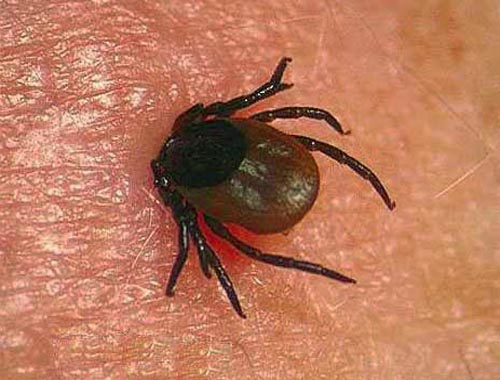Lyme Disease
Lyme disease is the most common tick-borne disease in the United States. In 2011, the Centers for Disease Control and Prevention (CDC) recorded recorded 24,364 cases as confimed and 8,733 cases as probable. The infection is caused by Borrelia burgdorferi, a spiral-shaped bacterium (spirochete) named after Dr. Willy Burgdorfer, the public health researcher who discovered it in 1982. The infection is often contracted during warm-weather months when ticks are active. The spirochete enters the skin at the site of the tick bite. After incubating for 3-30 days, the bacteria migrate through the skin and may spread to lymph nodes or disseminate through the bloodstream to organs or distant skin sites. Lyme disease frequently presents with a skin rash called erythema migrans (EM) and common flu-like symptoms of fever, malaise, fatigue, and muscle and joint pains. The characteristic EM rash is a flat or raised red area that expands, often with clearing at the center, to a diameter of up to 20 inches. However, it does not always occur, which can make the diagnosis more difficult, especially when the patient is not aware of having been bitten by a tick. Other early signs may include small skin lesions, facial nerve paralysis, lymphocytic meningitis, and heart-rhythm disturbances. Early infections usually are cured by two to four weeks of orally administered antibiotics (amoxicillin or doxycycline). However, if untreated or inadequately treated, neurologic, cardiac, or joint abnormalities may follow. Worldwide, Lyme disease has been directly responsible for fewer than two dozen deaths. The disease is named after the town of Old Lyme, Connecticut, where researchers recognized its nature in 1975. In Europe, associations between tick bites and several skin diseases had been known for decades, but it was not understood that various conditions were part of a single illness. Since its nature was clarified, Lyme disease has emerged as a significant source of public controversy. Some people claim to be persistently infected with B. burgdorferi and suffering from debilitating symptoms as a result. While Lyme disease isn't incredibly uncommon, it isn't always easy to diagnose on initial examination by a physician. Caused by a tick-borne virus, it usually manifests in flu-like symptoms, sometimes resulting in a characteristic red, raised rash. This often doesn't occur, however, and if a patient is unaware of having been bitten by a tick, a diagnosis can be quite hard to come by. Making the process more difficult are lab tests that aren't always reliable and a wide range of misinformation about the disease in the media.
